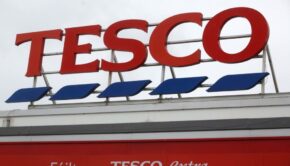New boss at Tesco will need to make radical changes

Tesco’s new boss Dave Lewis has a huge job on his hands to attempt to turn the company’s fortunes around. Dan White believes that drastic times call for drastic measures
13 August 2014
The ousting of Philip Clarke as Tesco chief executive has major implications which will extend far beyond Britain and Ireland’s largest grocery retailer. Ever since he took over as Tesco chief executive from Sir Terry Leahy in March 2011, Philip Clarke has been under pressure. Having been the undisputed king of the aisles for almost two decades, Tesco is now feeling the heat from the German discounters Aldi and Lidl on both sides of the Irish Sea.
It was, as these things go, handled in a reasonably humane manner. Clarke will remain in situ as chief executive and a director until October and “will continue to be available to support the transition” until the end of January 2015. The Tesco statement announcing his departure also praised his “outstanding achievement” at the company.
Taking on an outsider
However, the honeyed words notwithstanding, there was no disguising the brutal reality of the situation. Philip Clarke had effectively been sacked and replaced by Unilever executive Dave Lewis, the first time an outsider has been appointed to run Tesco in the company’s 95-year history.
When Sir Terry walked out the door of Tesco’s Cheshunt headquarters for the last time four years ago, it seemed as if the UK’s largest retailer could do no wrong. Under his 14-year leadership annual pre-tax profits had almost quintupled from £750m to £3.5bn while its sales more than quadrupled from £15bn to £67.6bn.
During that period its UK market share had risen from 22% to 31%. Sir Terry also spearheaded Tesco’s international expansion into Eastern and Central Europe, the Far East, the United States and Ireland.
Profit warning
Unfortunately it quickly became clear that Sir Terry’s legacy to his successor was less glimmering than was immediately apparent. The unfortunate Clarke was hardly a wet day in the job when he was forced to issue a profit warning, Tesco’s first for 20 years, in January 2012.
It was downhill all the way after that. Tesco’s UK market share began to slip under pressure from the rise and rise of the discounters and a resurgent Sainsburys. Its UK market share is now down to 28.9% while the combined discounters’ share is up to 8.4%.
The discounters have inflicted even more damage on Tesco’s Irish business, which it acquired in 1997. Its Irish market share has fallen to just 26.1% while the combined discounters’ market share is now up to 16.3%.
Tesco overseas
Tesco’s other overseas operations have if anything fared even worse than its Irish arm. Tesco offloaded its Japanese business in 2012 and folded its Chinese subsidiary into a joint venture with a local partner in 2013. However, Tesco’s biggest overseas disaster was undoubtedly its US business Fresh & Easy.
British retailing history is littered with examples of UK household names, including Sainsburys and Marks & Spencer, who have come a cropper in the United States. It was, Sir Terry assured us, going to be different for Tesco.
Instead of buying an existing business Tesco was going to develop a new chain from scratch, Fresh & Easy, on the west coast. Specialising in fresh produce and ready meals the Fresh & Easy stores were about 15,000 square feet, about one-third of the size of the average US supermarket.
Despite extensive market research, Fresh & Easy bombed with US shoppers who, it turned out, preferred traditional full-size supermarkets after all. By the time Tesco finally pulled the plug on Fresh & Easy in September 2013 the total cost, including accumulated losses, was estimated at £1.2bn, putting it firmly at the top of the league table of UK retail disasters in the US.
When Lewis takes over as chief executive in October he is likely to ditch more of Tesco’s overseas operations with the future for the company likely to be focused on its core UK and Irish businesses.
When Lewis takes over as chief executive in October he is likely to ditch more of Tesco’s overseas operations with the future for the company likely to be focused on its core UK and Irish businesses
The principal challenge facing Lewis is how does Tesco cope with the rise and rise of the discounters in the UK and Ireland? Since their arrival on these islands around the turn of the century Aldi and Lidl have rewritten the rules of grocery retailing.
The old attachment to the “one stop shop”, where consumers loaded up the supermarket trolley once a week or a fortnight is gradually being replaced by more frequent, smaller shops with consumers seeking out the best value in particular items. Consumers’ loyalty to brands is also being undermined as they switch to private-label to try and make their shopping budget stretch further.
Private-label now accounts for 48% of grocery sales by value in the UK and about 37% in this country. The rise and rise of the discounters has been extraordinarily effective in weaning Irish shoppers off their traditional loyalty to brands.
With the discounters rampant and shoppers turning away from giant superstores, where does Tesco go from here?
Price needs to be right
If we can learn anything from the rise of the discounters it is that, with disposable incomes flat or falling, price is very, very important for most shoppers. So why doesn’t Tesco use the muscle which its still enormous market share in the UK and Ireland gives it to launch a good old-fashioned price war?
While a price war would certainly hit Tesco’s bottom line, does Lewis really have a choice? The continued erosion of its market share will eventually wipe out those profits anyway.
If he does decide on a price war, Lewis could go one step further. Tesco revolutionised grocery retailing when it introduced its Clubcard loyalty card in 1995. So successful was Clubcard that all of the other major retailers were quickly forced to follow suit.
While Clubcard was crucial to Tesco’s success in the nineties and noughties, this success came at a price. Retail analysts reckon that Clubcard costs Tesco £500m a year – enough to fund a heck of a lot of price cuts.
So will Lewis take the radical step of dumping Clubcard? If he did would the other grocery retailers in Britain and Ireland follow suit? Would they have any choice?
Could the Clubcard be scrapped?
What is clear is that scrapping Clubcard would be a game-changer. Those who know their retailing history will need no reminding that Tesco has been here before. In June 1977 Tesco, which was then under pressure from 20% annual inflation and the Kwiksave discount chain, stunned its customers and competitors when it threw out Green Shield stamps and cut its prices instead.
Is history about to repeat itself? Desperate situations demand desperate remedies. With Lewis’ outsider status meaning that he owes no loyalty to Clubcard, don’t be surprised if he does what was previously considered unthinkable at Tesco.



 Print
Print






Fans 0
Followers